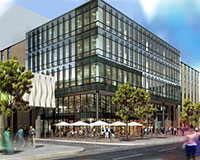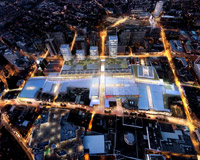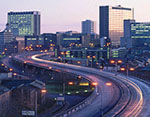 The picture on the box shows a vibrant town centre emerging from a period of decay and decline. The problem facing those putting the jigsaw of a renewed Croydon together is that a vital number of pieces appear to be missing.
The picture on the box shows a vibrant town centre emerging from a period of decay and decline. The problem facing those putting the jigsaw of a renewed Croydon together is that a vital number of pieces appear to be missing.
While residential schemes are sprouting all over the borough (see box) and plans are progressing for Westfield’s and Hammerson’s redevelopment of the Whitgift Centre, Croydon is struggling to deliver office space.
Jo Negrini, the ebullient executive director for regeneration at Croydon council, says that the council is working on a long-term strategy to improve the town’s commercial core, but that it will take time. “Croydon is not one homogenous place. It is lots of different areas and that’s also its strength,” she says.
Earlier this year, the council’s annual monitoring report revealed that just over half of Croydon’s office stock was vacant. This is not surprising, given that there has been virtually no development for two decades.
The only substantial new-build to emerge in that time was Abstract Land’s 100,000 sq ft Renaissance, near East Croydon station (pictured above). It was let to local occupiers on long leases at rents of up to £23.50 per sq ft, less than a year after it completed in late 2013, which demonstrates that demand is there.
“If I had the right site, would I develop there tomorrow?” asks Abstract chief executive Mark Glatman. “Absolutely!”
Finding the right site means purchase costs of £50 per sq ft or less and the boom in housing has pushed up prices. “The issue is that land is going for £100 per sq ft and it’s very difficult to make office development work at that level,” says Savills director Andrew Willcock.
Prime rents are struggling to get into the mid-£20s per sq ft – ironically a selling point for luring back-office functions away from overheated central London rents.
Only one large grade A-quality building is available: Canmoor’s and CarVal’s refurbished 180,000 sq ft Interchange, next to West Croydon station, which is quoting a rent of £22.50 per sq ft. “There’s been an increase in the past six months of people looking at decanting staff from central London,” reports Canmoor director Tom White.
What happens once that space is gone is not clear. While there is an impressive potential pipeline of more than 2m sq ft, how quickly it will come forward is not known.
Refurbishment options are limited, too. Will Foster, partner at Knight Frank, says: “The development hiatus from the late-1980s means there are few buildings that have the large floorplates and high slab heights to make refurbs viable.”
Croydon eclipses London boroughs for most resi conversions
 The forest of cranes marshalled across Croydon’s skyline is hoisting up materials for a bold new generation of homes in the borough. Over the next five years 9,500 homes could be built and many will use former office blocks, according to Colliers International research.
The forest of cranes marshalled across Croydon’s skyline is hoisting up materials for a bold new generation of homes in the borough. Over the next five years 9,500 homes could be built and many will use former office blocks, according to Colliers International research.
Croydon specialist agent Sinclair Clark estimates that in the past two years, 2m sq ft of office space has disappeared because of the appetite for residential development, and more is likely to follow.
Under the government’s permitted development rights legislation, the number of residential conversions in Croydon has rocketed. It is home to more schemes than any other London borough, accounting for just shy of a whopping 1,600 units, or just over one-sixth of the Greater London total.
According to EGi’s London Residential Research, half of the 10 largest PDR applications in the year to May 2014 were located in the borough. Nigel Evans, head of London Residential Research, says: “In Croydon, a single PDR application in that year was bigger than all the ‘normal’ office-to-residential applications in the last decade, combined.”
That scheme, Criterion Capital’s Delta Point, (pictured above) should see the 14-storey, 313,000 sq ft former office block on Wellesley Road converted into 350 homes.
Is Croydon Shoreditch 2.0?
Mention Tech City and the chances are the immediate associations will be Old Street Roundabout and Shoreditch. Jonny Rose is on a mission to add another name to the list: Croydon.
By day, the 27-year-old English graduate works for online content marketing platform Idio in London’s West End, but in his spare time he is banging the drum for his home town in south London, as co-founder of tech business support organisation and community #Croydon #TechCity.
“When you break it down, a tech city is simply a cluster of businesses working in software and utilising the internet,” he says.
The number of tech businesses operating in and around Croydon has grown by nearly 40% in the past two years, though even Rose admits that the town was starting from a low base.
That has not stopped it from fielding some big hitters, such as AIM-listed Dotdigital, owner of automated email marketing specialist Dotmailer.com. The company, now with a market capitalisation just short of £100m, still retains a strong Croydon presence 15 years after starting up in the town.
A recent arrival is Pro-G Media, parent of video game review site videogamer.com, which has around 3m members.
But Croydon has some way to go to match the 4,000 tech companies now blinking brightly in east London. ONS figures from earlier this year show that just over 1,000 early-stage digital, technical and creative businesses are located in Croydon and around only one-fifth of these are in the heart of the town centre.
The total is a third less than in Brighton, but Rose is confident that change is on its way. He says: “Croydon now is what Shoreditch was like 10 years ago. There are a lot of inexpensive offices and the place is a bit edgy. We represent the epicentre of south London’s tech community – we’re pulling in people from many different directions, like Clapham, Sutton and Reigate.”
Rose admits that perceptions of Croydon as being far away from central London are acting as a brake on the town’s attractiveness, along with the lack of a clear identity. And while the Croydon Partnership’s redevelopment of the Whitgift Centre is welcomed in broad terms, Rose is clear: “We don’t want Croydon to become solely known as a retail destination. We want tech to become the all-encompassing narrative for the borough.”
Retail update
 Westfield’s and Hammerson’s £1bn makeover of the Whitgift Centre (pictured left) is awaiting a planning inspector’s report, expected in February 2015, after Croydon council issued a CPO this Easter.
Westfield’s and Hammerson’s £1bn makeover of the Whitgift Centre (pictured left) is awaiting a planning inspector’s report, expected in February 2015, after Croydon council issued a CPO this Easter.
Most of the 130 objections are technical, says Westfield development director John Burton, who is hoping that the 2m sq ft scheme can remain on track for a 2019 opening.
Last month, a high court judge dismissed claims by a small group of leaseholders that the plans were “not viable.”











